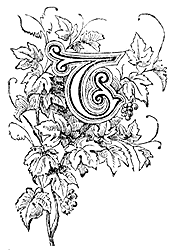 |

HIS extremely beautiful and noble dwelling is situated in Staffordshire, near the borders of Derbyshire.
The routes to Alton Towers run from Manchester, Derby and the Staffordshire Potteries, and though springing from centres of industry, are of themselves so pretty that they prepare the traveller for the extremely charming and even splendid place to which they conduct him. From Manchester we travel by Stockport, Macclesfield, Leek and Oakamore, through the charming valley of the Churnet; if we go from Derby we pass Sudbury, with its grand old church and castellated ruins, and the other route is equally picturesque.
The gate or entrance from the Uttoxeter Road Quicksall Lodge ushers the visitor into a magnificent approach to the Towers, called the Earl's Drive. It is three miles long, and leads along the vale of the Churnet; at last the conservatory by the house is seen, and then the Towers of Alton appear through the trees - spire and arcade, dome and gable.
The gardens of Alton are wonderfully beautiful, a perfect specimen of the landscape gardener's work, and they are ornamented with temples, fountains, statues and exquisite vases. The chief conservatory contains a palm house and an orangery. Among the ornaments of the gardens is the Gothic temple, four stories high. A magnificent view is obtained from the top: the Flag Tower, which is a massive building, with four turrets, and is six stories high, is also a prospect tower.

There is an imitation of Stonehenge; Ina's Rock, at which, after a great battle with the king of Mercia, Ina, king of the West Saxons, held a parliament; and in the vicinity of the Towers is Alton Castle, with the picturesque ruins of some monastic buildings in which the early lords of Alton are buried. Alton Church, a Norman building, is beautifully situated, and is also near the castle. Demon's Dale, a valley to which many extraordinary legends belong, and Croxden Abbey, a grand old ruin founded in 1176, are both in the near vicinity. This abbey was founded by Bertram de Verdun, the first Norman baron who was owner of the manor and stronghold of Alton.
He obtained Alton by marriage, for it had been restored by the Norman sovereign to the original Saxon possessors, and Rohesia, the daughter and heiress of the last of these, married Bertram, who thus became its lord. Rohesia died in 1215, leaving amongst other children, Nicholas, whose descendants contracted an alliance with the Lacies of Meath, Ireland. One of these, Theobald de Verdun, was Baron Verdun in 1306. He had three daughters, one of whom married Thomas, Lord Furnival, and took him as her portion, Alton. Lord Furnival was fined £200 for marrying this lady without the royal permission. Through a female descendant the estates and title passed to Thomas Neville, who became thus fifth Baron Furnival. His eldest daughter Maude, "the lady of Hallamshire," married in 1408 Sir John Talbot, afterwards Earl of Shrewsbury, and conveyed Alton to the Talbots, who have been in possession of it for five centuries. This Sir John Talbot was the great warrior who was called the scourge of France, and with whose name French mothers hushed their babes. He was slain with his son at the siege of Chatillon, in the eightieth year of his age.
George, seventh Earl of Shrewsbury, married the famous Bess of Hardwick, who built Chatsworth and Hardwick Hall. She was the daughter of John Hardwick, of Hardwick Hall, Derbyshire.
To this nobleman Elizabeth confided the safe keeping of Mary, Queen of Scots.
He was succeeded by his son, who died childless, and the estates passed to George Talbot, of Grafton, who succeeded as ninth earl. By regular descent the title passed to the twelfth earl, who was created Duke of Shrewsbury and Marquis of Alton by George I., but as he died without issue the dukedom and marquisate became extinct.
In 1858 Earl Talbot established his claim to the estates, and his son was the nineteenth earl.
Alton Towers were not the old home of the family; they were built by the fifteenth earl, a man of extraordinary taste and judgment The castle of the De Verduns stood on an eminence; where the Towers stand was then the plain dwelling of the steward. The earl perceived that this spot afforded great capabilities of building, and space for the landscape gardener, and he erected this magnificent home. He merited the inscription on his beautiful cenotaph "He made the desert smile."
|
 |